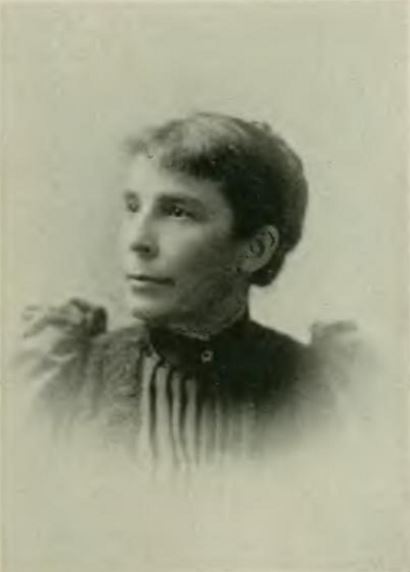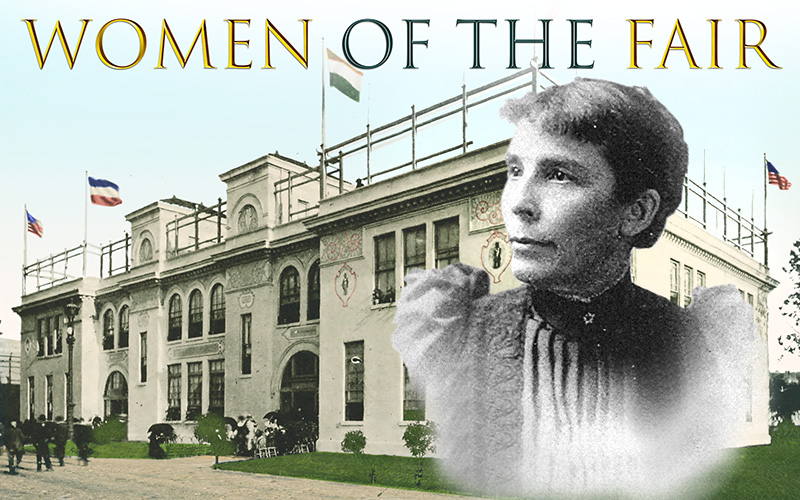“There are some crusty old bachelors and a few childless women who make a pretense of disliking children, but it’s a flimsy sort of sour-grape antipathy, and rarely rings true. Even those people who do not like children’s society will find a great deal to enjoy in their domicile.” —Emma. B. Dunlap, writing about the Children’s Building at the 1893 World’s Columbian Exposition.

Clara Doty Bates. [Image from A Woman of the Century edited by Frances E. Willard and Mary A. Livermore (Charles Wells Moulton, 1893).]
Author
A well-known children’s author, Bates regularly contributed to several leading juvenile periodicals of her day, including St. Nicholas, The Youth’s Companion, Golden Days, and Wide Awake. She published numerous books beginning in 1876, with Selections from Aesop’s fables, versified by Mrs. Clara Doty Bates being among her best-selling. [“Clara Doty Bates Dies”]
In 1877, Bates moved to Chicago with her husband, Morgan Bates, a newspaper man. During those years of Chicago’s rapid growth between the Great Fire and the World’s Fair, she became “an earnest worker in everything pertaining to the elevation and improvement of her sex.” [“Clara Doty Bates Dies”]
Cover of Clara Doty Bates’ On the Way to Wonderland (D. Lothrop and Co., c1885). [Image from the University of Florida George A. Smathers Library.]
World’s Congress Auxiliary Literary Congress
As chairwoman of the World’s Congress Auxiliary Committee on Literature for Children, Bates wrote a poem set to music and sung by a youth choir for the opening of the “Children’s Afternoon” program on July 13, 1893. [“For Men of Letters”][“Little People Meet in Congress”] Several days later, Bates spoke at the Congress on Education, held on July 18. [“Youth Has Its Day”]
Not all of her writing was for the entertainment of the little ones. She published in periodicals such as Godey’s Lady’s Book and Peterson’s Magazine. Prior to the opening of the Columbian Exposition, Bates gave a presentation to a group of 150 Chicago society women on December 6, 1892. Unfortunately, her paper on “The Science of Women” appears to be lost.
The Children’s Building. [Image from World Columbian Exposition Illustrated, July 1893.]
Hostess of the Children’s Building library
Bates’ legacy for the 1893 World’s Fair is her role as head of the library inside the Children’s Building. Her article “The Children’s Building” published in the May 1893 issue of The Review of Reviews (reprinted here) describes the various contributions women made to the construction and programming of the Children’s Home at the Fair.
Bates organized donations for the young people’s library from publishers and authors around the country. Her Committee on Literature for Children aimed to “select the library from the child’s and youth’s standard, not from the point of view of the adult,” writes Emma B. Dunlap in her review of the Children’s Building. “The books the children most longed for were to be upon the shelves, rather than the books their elders thought most suitable to them. To really get at an average preference in children, boys and girls of all ages were consulted and asked to send lists of their favorite books.”[Dunlap, 164]
When publishers declined to send books from their catalogs, her committee sent requests directly to authors and had greater success. The library was stocked with 150 volumes, many of which were signed copies by such prominent authors as the late Louisa May Alcott, Oliver Wendell Holmes, Frank R. Stockton, and Hjalmar Hjorth Boyesen. Children’s books in French, Italian, Spanish, Chinese, Japanese, German, Bohemian, Belgian, and English filled the shelves. [Johnson, 255] Children’s magazines and periodicals—American, English, French, and German—also were available for reading.
Photograph of the library of the Children’s Building. [Image from Jenks, Tudor The Century World’s Fair Book for Boys and Girls. The Century Co. 1893.]
The Children’s Building was “her daylight home,” wrote the Chicago Times-Herald. “Many of the daintiest features of the programmes there were her devising”. [“Clara Doty Bates”] Bates reportedly was at her post in the library every day, where she “received mothers and little ones from all parts of the world.” [“Clara Doty Bates Dies”] The library was “thronged with visitors all the time, not all of whom are children,” recorded librarian Caroline Harwood Garland. “In this room may always be seen children contentedly reading; sedate men and women making lists of books for the children at home; eager young faces studying the pictures on the walls; and the flying tourist, who puts his bead inside the door, takes one glance and departs, thinking he has seen it all.” [Garland, 285]
The Children’s Building. [Image from Our World Exhibition: A Description of the Columbian World’s Fair in Chicago, 1893 (Fred. Klein Co., 1894).]
Legacy
Bates died in Chicago on October 14, 1895, when the memory of the World’s Fair was still fresh in the minds of many who had attended. She is buried in Forest Hill Cemetery in Ann Arbor, Michigan.
In his tender memorial published in the Chicago Record, the great poet Eugene Field recalled Bates’ “every manner of good work in this city,” and noted that it was “in the quieter spheres of usefulness that this lady preferred and loved to move; her retiring nature found congeniality in those secret ministrations for which the poor, the sick and the afflicted, whom she succored, now bless her memory.” [Field]
The children’s library that she so thoughtfully assembled and lovingly tended to was to be kept intact after the close of the 1893 World’s Fair, intended for a memorial women’s building. The Chicago Time-Herald predicted that “years hence, when this shall be, many who are children to-day will pause before a well-beloved name, there to be duly written.” [“Clara Doty Bates”]
Although Clara Doty Bates’ name then was “known and revered in every household in the country where the best character of literature for children is read” [“Clara Doty Bates Dies”], she is today not well remembered.
Surrounded by some of the most stunning attractions of the Fair—a tower of electric lights, a giant rotating wheel, Venetian gondola rides, a giant telescope, and illuminated fountains—her little library inside the Children’s Home offered a cozy escape for the boys and girls who preferred the simpler pleasure of a good book.
An illustration from Fame’s Tribute to Children (Hayes and Co., 1893), a collection of autograph sentiments contributed by famous men and women to raise funds for the Children’s Building.
SOURCES
“‘At Home’ To Babies” Chicago Daily Tribune June 2, 1893, p. 3.
https://www.chipublib.org/fa-worlds-congress-auxiliary-congress-of-authors-collection/
“Clara Doty Bates Dies” Chicago Daily Tribune Oct. 15, 1895, p. 12.
“Clara Doty Bates” Chicago Times-Herald Oct. 15, 1895.
Dunlap Emma B. “The Children’s Building.” in Art and Handicraft in the Woman’s Building of the World’s Columbian Exposition, Chicago, 1893. Elliott, Maud Howe, ed. Rand, McNally & Company, 1894.
Field, Eugene “Clara Doty Bates” Chicago Record Oct. 12, 1895.
“For Men of Letters” Chicago Daily Tribune July 9, 1893, p. 12.
Garland, Caroline Harwood “Some of the Libraries at the Exposition” Library Journal August 1893, p 190.
Johnson, Rossiter A History of the World’s Columbian Exposition Volume 1 – Narrative. D. Appleton and Co., 1897.
“Little People Meet in Congress” Chicago Daily Tribune, July 14, 1893, p. 8.
“Youth Has Its Day” Chicago Daily Tribune July 19, 1893, p. 3.

